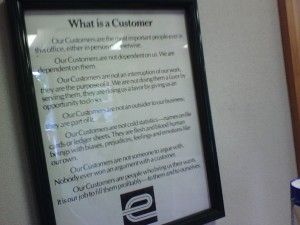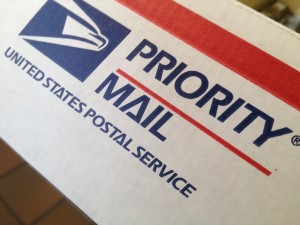August 13th, 2014 by Elma Jane
No sales manager wants to hear that his or her team is losing sales. For some companies, customers jump ship or don’t give them a chance at all, because of a negative experience with an individual sales representative. The outcome of a bad in-person sales experience is more dramatic than just a delay in the sales cycle. In fact, according to a recent survey and research, 70 percent of marketing and sales professionals said a bad sales call results in a loss of revenue and 70 percent noted that it can take months or even years, to recover from it, but for many organizations, lost revenue doesn’t just occur because of bad sales calls. Often, small inefficiencies in the sales process add up to a lot of wasted time and by extension, wasted opportunities.
Sales teams spend 30 to 50 percent of their time not selling, they’re calling, chasing and waiting, trying to get the customer to agree to an appointment. When you change this behavior and drive it down, sales go way up.
How can sales managers solve these issues that stand in the way of growth? Gathering customer feedback may seem like the obvious answer, but before you do, try seeking internal feedback from your team about where they’re struggling.Managers should look at underperforming sales reps and inquire about the obstacles that are keeping them from being successful, is it training or the enablement material? Can they find the right material for each stage of the sales cycle? It’s important that managers understand both the positive and negative patterns so they can provide critical feedback to marketing on content effectiveness and help salespeople orchestrate better conversations.
Another effective strategy for collecting useful feedback is to ask employees what tactics are helping them to succeed. Ask them for the single best thing they’re doing relating to sales. Questions that ask for just one thing generate the best results. It’s easy to act on those answers and it’s valuable and engaging to share them transparently with the rest of the team. Once you’ve asked your team about their process and figured out what’s working, there’s one last question you need to ask yourself as a sales manager, what do you need to stop doing as an organization to free up more time for the tactics that actually work?
If your team is wasting a lot of time on nonselling activity, the best thing to do is eliminate that dead time of waiting around for the phone to ring. Sales teams confuse making 70 phone calls to prospective clients and leaving messages with selling. That activity is not selling. Get prospects engaged in a productive conversation the first time you pick up the phone or meet them by finding out what the customer’s problem is, and if your product or service can solve it.
Posted in Uncategorized Tagged with: companies, customers, marketing, organizations, product, sales, sales calls, sales process, Sales teams, service
May 16th, 2014 by Elma Jane
As much as you’d like to hope that no one will ever be unhappy with your product or service, you’re almost guaranteed to encounter at least a few customers who are less than fully satisfied. Where there are customers, there are complaints.
As consumers increasingly air their grievances about brands on social media, the focus has turned to the way those brands respond to customer complaints, especially in a public forum. Knowing what to do in this situation makes all the difference when it comes to re-earning a customer’s business and what he or she tells others about your company.
Great service is about getting your customers to trust you and count on a consistent experience, but that doesn’t mean you’re always going to be perfect. In a crisis, you can elevate your stature with how well you handle the situation. A negative experience can be the best time to show your value.
Great service has to come from the top. Lower level employees aren’t going to be inspired and motivated unless they see their leader providing exceptional service.
No matter which person on your team is responsible for handling customer relations, it’s imperative that you embody excellent service as the head of the company as well.
If faced with negative customer experience follow these steps to resolve the issue and regain customer’s trust.
Acknowledging the problem – Customer is always right classic customer service cliché. While it may in fact, turn out to be a misunderstanding, the worst thing you can do is dismiss a customer who tells you he or she had a problem with your business.
Apologizing for it – Once you’ve acknowledged the customer’s issue, apologize for it and ask what you can do to help. Gather the facts about the situation and determine a course of action from there.
Taking action – Saying you’re going to fix a problem is one thing, actually doing it is another. Make sure you honor your commitment to take care of the customer’s complaint. If you can’t correct the problem, offer a coupon or voucher as a way to ask the customer for another chance.
Follow up – When you’ve done what you promised to do, follow up with the customer to make sure that your solution was satisfactory.
Posted in Best Practices for Merchants, nationaltransaction.com Tagged with: brands, consumers, coupon, customer relations, customers, forum, product, public forum, service, social media, value, voucher
December 2nd, 2013 by Elma Jane
Post Office launches new payments service to help small businesses make more money.
The Post Office in partnership with WorldPay, has launched a new card payment service to help sole traders and small businesses. The Post office which services around four million small businesses, will offer them a range of ways to take secure card payments made in-store, online, via mail or telephone order, or on the move, which it hopes will plug a 20 per cent revenue gap between firms that accept card payments and those that don’t. According to new WorldPay research, 87 per cent of customers are likely to spend more money per transaction when paying with a debit or credit card, as opposed to cash.
The study also showed during the past year, one in five of UK consumers has had to abandon a purchase due to a small business or sole trader not accepting cards or because they weren’t carrying enough cash to pay. The service includes card machines for in-store payments or those made via mail or telephone order, and online payment pages for websites.
There is also a Pay As You Go option for sole traders and mobile businesses, like hairdressers or beauty therapists, who can sign up to take secure Chip and PIN card payments.
Posted in Credit card Processing, Electronic Payments, Mail Order Telephone Order Tagged with: card payments, Chip and PIN, credit-card, in-store, mail or telephone order, online, payment, purchase, secure, service, transaction, worldpay
November 21st, 2013 by Elma Jane
Eco Tips For Greening Business. Creating a greener office can result in a healthier and more productive work place, a lighter ecological footprint, increased staff morale and good news for your bottom line. So whether you work in an office, shop or factory, run your own business or manage a corporation… taking care of the environment is easier than you think.
Here’s some simple, yet effective tips for going green at work by saving energy, conserving natural resources and reducing landfill and preventing pollution.
A Switch to 100% Recycled Office Paper. Every tonne of paper recycled can save 17 trees. The best paper to buy is bleach-free, 100% post-consumer recycled paper (usually off-white or brown in color), because it uses up to 90 per cent less water and half the energy required to make paper from virgin timber, creates demand for waste paper that would normally end up in landfill, and no trees are cut down to make the paper. Genuine recycled paper is 100% made from post-consumer waste. This means the paper has been used at least once by consumers, collected, and reconverted to pulp to make paper again. But check the fine print because some paper manufacturers call paper recycled even when it uses pre-consumer waste… meaning pulp that never left the factory. A business is not truly recycling unless it buys recycled products.
Changing A Light Bulb. Compact fluorescents are 80% more energy efficient, and last 10 times longer than incandescent light bulbs. A switch from conventional light bulbs to energy efficient compact fluorescents can be one of the most effective things your business can do to reduce emissions and global warming, and it saves you money off your energy bill too.
Green Power. Your business can save tonnes of emissions a year, by switching to renewable sources such as solar, wind and geothermal energy.
Green Printer. Look for a printer who uses vegetable-based inks, and can assist you to choose paper made from sustainable forest fibres or better still, paper recycled from post-consumer waste. Next time you are arranging the printing of your stationery or printing material, get a comparison quote from a ‘green printer’. You might be pleasantly surprised to learn how competitive the costs are compared to traditional, alcohol-based, offset printing.
How White Is Your Paper? When you buy chlorine-free writing and copier paper you’re telling paper manufacturers that you demand safer alternatives. So, choose recycled paper with a high percentage of ‘post consumer’ waste, and look for the ECF or TCF symbols to ensure that environmental harm is minimized. ECF (Elemental Chlorine Free) means pulp is bleached without the use of elemental chlorine gas. Even better, TCF (Totally Chlorine Free) means pulp is bleached avoiding the use of chlorine at all. Paper manufacturers use chlorine to bleach paper bright white. The more chlorine our society uses, the more toxic substances such as dioxin there are in our water, air, soil, and in our bodies.
Implementing Green Cleaning Program. Green cleaning is not only good for the environment; it also increases workplace health and safety. Switch to environmentally responsible cleaning products and services.
Natural Air Filters Are Indoor Plants. Use Indoor plants they are natural air filters which can absorb airborne pollutants and radiation from computers while replenishing oxygen levels.
Put Your PC To Sleep. Save approx. $100 per year off your energy bill for every computer you switch off at the end of the day. If you are away from your computer for less than half an hour, put it in sleep mode, which reduces energy use to about 5% of full operating power. Also next time you’re replacing office computers, remember that laptops and notebooks use up to 90% less energy than a desktop PC. Many office computers never get switched off, needlessly consuming energy overnight and on weekends. A computer left on all day, every day uses 1,000 kilowatts of electricity over a year, producing more than a tonne of carbon emissions.
Recycling Program. Different Councils may have different regulations about what you can recycle. Kerbside collection has changed the face of office and household recycling, making it easier to reduce landfill.
Recycle The Cartridges From Your Printer, Fax And Copier For Free. Contact a free collection service that recycles all your ink jet and toner cartridges and guarantees zero waste to landfill.
Recycle Your Old Mobile Phone. Preserve the environment by keeping unused mobile phone out of landfill and recycling it back to reuse. Look for official industry recycling program that provides a solution to help clean up the environment while at the same time raising much needed funds for charities.
Treat Paper Like It Grows On Trees. Simple recycling measures can significantly reduce your waste removal expenses. Set your computer printing default to double-sided. Print out only what is necessary, and proof read documents carefully on screen to avoid having to print multiple copies. Use a paper tray to collect single-sided printed scrap paper for notes, or reuse it in your photocopier or fax machine. Place a paper recycling box under each desk, and encourage your team to transfer the contents into a centrally located recycling bin when full. Paper comprises up to 70 per cent of office waste, with 10,000 A4 sheets used for every worker each year. That’s equal to 10 million trees.
Waterless Urinals Installation. Every year, billions of litres of fresh drinking water are wasted in urinals flushing. Waterless urinals are best to use, absolutely no water while meeting the highest hygienic standards.
Go Green!!!
Posted in Electronic Payments, Environmentally Green Tagged with: electronic payments environmentally, energy efficient, environmentally green, green, greener office can, greening your business, lighter ecological footprint, merchant, payments environmentally green, service, the environment



